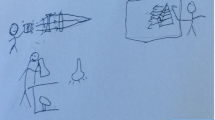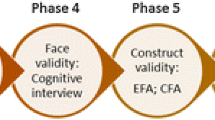Abstract
A survey instrument using everyday teaching scenarios was developed to measure teacher conceptions of inquiry. Validity of the instrument was established by comparing responses for a group of secondary teachers to narrative writing and group discussion. Participating teachers used only three of the five essential features of inquiry detailed in the standards documents (NRC 2000) when expressing their ideas of classroom inquiry. The features of ‘evaluating explanations in connection with scientific knowledge’ and ‘communicating explanations’ were rarely mentioned. These missing components indicate a gap between the teachers’ conceptions of inquiry and the ideals of the reform movement.
Similar content being viewed by others
References
American Association for the Advancement of Science. (1989). Science for all Americans. New York: Oxford University Press.
Beerer, K., & Bodzin, A. M. (2004, January). Promoting inquiry-based science instruction: The validation of the science teacher inquiry rubric (STIR). Paper presented at the annual meeting of the Association for the Education of Teachers of Science, Nashville, TN.
Bell, P., & Linn, M. (2000). Scientific arguments as learning artifacts: Designing for learning from the Web with KIE. International Journal of Science Education, 22, 797–817.
Biological Sciences Curriculum Study. (2005). Is it inquiry or is it not?: Inquiry card sort. Retrieved November 14, 2006, from http://promse.msu.edu/_documents/Science%20as%20Inquiry-%20handouts.pdf.
Bybee, R. W. (2000). Teaching science as inquiry. In J. Minstrell & E. H. van Zee (Eds.), Inquiring into inquiry learning and teaching in science (pp. 20–46). Washington, DC: American Association for the Advancement of Science.
Carnes, G. N. (1997, April). Teacher conceptions of inquiry and related teaching practices. Paper presented at the annual conference of the National Association for Research in Science Teaching, Oak Brook, IL.
CPB Annenberg. (1997). Case studies in science education. Retrieved August 11, 2006, from http://www.learner.org/resources/series21.html.
Crawford, B. A. (1997, April). A community of inquiry: Changing roles for teachers and students. Paper presented at the annual conference of the National Association for Research in Science Teaching, Oak Brook, IL.
Crawford, B. A. (1999). Is it realistic to expect a preservice teacher to create an inquiry-based classroom? Journal of Science Teacher Education, 10, 175–194.
Crawford, B. A. (2000). Embracing the essence of inquiry: New roles for science teachers. Journal of Research in Science Teaching, 37, 916–937.
Driver, R., Newton, P., & Osborne, J. (2000). Establishing the norms of scientific argumentation in classrooms. Science Education, 84, 287–312.
Duschl, R. A., & Grandy, R. E. (2005, February). Reconsidering the character and role of inquiry in school science: Framing the debates. Paper presented at the Inquiry Conference on Developing a Consensus Research Agenda, Sponsored by the National Science Foundation, Rutgers University, Newark, NJ.
Duschl, R., & Osborne, J. (2002). Supporting and promoting argumentation discourse in science education. Studies in Science Education, 38, 39–72.
Duschl, R. A., Schweingruber, H. A., & Shouse, A. W. (Eds.). (2006). Taking science to school: Learning and teaching science in grades K-8. Washington, DC: National Academy Press.
Fenstermacher, G. (1994). The knower and the known: The nature of knowledge in research on teaching. Review of Research in Education, 20, 3–56.
Gott, R., & Duggan, S. (1996). Practical work: Its role in the understanding of evidence in science. International Journal of Science Education, 18, 791–806.
Hodson, D. (1998). Science fiction: The continuing misrepresentation of science in the school curriculum. Curriculum Studies, 6, 191–216.
Kang, N., & Wallace, C. S. (2005). Secondary science teachers’ use of laboratory activities: Linking epistemological beliefs, goals and practices. Science Education, 89, 140–165.
Keys, C. W., & Bryan, L. A. (2001). Co-constructing inquiry-based science with teachers: Essential research for lasting reform. Journal of Research in Science Teaching, 38, 631–645.
Keys, C. W., & Kennedy, V. (1999). Understanding inquiry science teaching in context: A case study of an elementary teacher. Journal of Science Teacher Education, 10, 315–333.
Louca, L., Elby, A., Hammer, D., & Kagey, T. (2004). Epistemological resources: Applying a new epistemological framework to science instruction. Educational Psychologist, 39, 57–68.
Luft, J. A. (2001). Changing inquiry practices and beliefs: The impact of an inquiry-based professional development program on beginning and experienced secondary science teachers. International Journal of Science Education, 23, 517–534.
Miles, M. B., & Huberman, A. M. (1994). Qualitative data analysis: An expanded sourcebook (2nd ed.). Thousand Oaks, CA: Sage.
Millar, R., & Osborne, J. (Eds.). (1998). Beyond 2000: Science education for the future. London: King’s College London.
Munby, H., Russell, T., & Martin, A. K. (2001). Teachers’ knowledge and how it develops. In V. Richardson (Ed.), Handbook of research on teaching (4th ed., pp. 877–904). Washington, DC: American Educational Research Association.
National Commission on Excellence in Education. (1983). A nation at risk: The imperative for educational reform. Washington, DC: U. S. Government Printing Office.
National Research Council. (1996). National science education standards. Washington, DC: National Academy Press.
National Research Council. (2000). Inquiry and the national science education standards: A guide for teaching and learning. Washington DC: National Academic Press.
Nott, M., & Wellington, J. (1995). Critical incidents in the science classroom and the nature of science. School Science Review, 76, 41–46.
Patton, M. Q. (1990). Qualitative evaluation and research method. Newbury Park, CA: Sage.
Putnam, R. T., & Borko, H. (2000). What do new views of knowledge and thinking have to say about research on teacher learning? Educational Researcher, 29, 4–15.
Roehrig, G. H., & Luft, J. A. (2004). Constraints experienced by beginning secondary science teachers in implementing scientific inquiry lessons. International Journal of Science Education, 26, 3–24.
Rop, C. J. (2002). The meaning of student inquiry questions: A teacher’s beliefs and responses. International Journal of Science Education, 24, 717–736.
Rowell, P. M. (2004). Shaping school science: Competing discourses in an inquiry-based elementary program. International Journal for Learning Technologies, 26, 915–934.
Sawada, D., Piburn, M. D., Judson, E., Turley, J., Falconer, K., Benford, R., & Bloom, I. (2002). Measuring reform practices in science and mathematics classrooms: The reformed teaching observation protocol. School Science & Mathematics, 102, 245–253.
Smith, M., & O’Day, J. (1991). Putting the pieces together: Systemic school reform. CPRE policy brief. New Brunswick, NJ: Eagleton Institute of Politics.
Strauss, A. L., & Corbin, J. (1990). Basics of qualitative research: Grounded theory procedures and techniques. Newbury Park, CA: Sage.
Tobin, K., & Tippins, D. J. (1996). Metaphors as seeds for conceptual change and the improvement of science teaching. Science Education, 80, 711–730.
van Driel, J. H., Beijaard, D., & Verloop, N. (2001). Professional development and reform in science education: The role of teachers’ practical knowledge. Journal of Research in Science Teaching, 38, 137–158.
Wallace, C. S., & Kang, N. (2004). An investigation of experienced secondary science teachers’ beliefs about inquiry: An examination of competing belief sets. Journal of Research in Science Teaching, 41, 936–960.
Welch, W. W., Klopfer, L. E., Aikenhead, G. S., & Robinson, J. T. (1981). The role of inquiry in science education: Analysis and recommendations. Science Education, 65, 33–50.
Westbrook, S. L. (1997, April). The lab’s done…now what? Paper presented at the annual conference of the National Association for Research in Science Teaching, Oak Brook, IL.
Windschitl, M. (2002, April). The reproduction of cultural models of “inquiry” by preservice science teachers: An examination of thought and action. Paper presented at the annual meeting of the American Educational Research Association, New Orleans, LA.
Windschitl, M. (2004). Folk theories of “inquiry”: How preservice teachers reproduce the discourse and practices of an atheoretical scientific method. Journal of Research in Science Teaching, 41, 481–512.
Yerrick, R., Parke, H., & Nugent, J. (1996). Struggling to promote deeply rooted change: The “filtering effect” of teachers’ beliefs on understanding transformational views of teaching science. Science Education, 81, 137–159.
Author information
Authors and Affiliations
Corresponding author
Appendix
Appendix
Scenario Survey Items
-
1.
Having students gather data for a local nonprofit organization.
-
2.
Giving students a white powder and asking them to determine what the powder is.
-
3.
Asking students to develop and answer their own questions about a local wetlands area.
-
4.
Having students follow a procedure to complete a lab.
-
5.
Asking students to use what they know about a local forest to decide whether an old-folks home should be built on that land.
-
6.
Having students classify substances based upon their observable properties.
-
7.
Having students use graphics on the Internet to explain how gas molecules move.
-
8.
Having students make presentations of data collected during a lab.
-
9.
Asking students to improve on a basic design (make an airplane fly further, make a motor spin faster, etc.).
-
10.
A class discussion about the arrangement of the periodic table.
About this article
Cite this article
Kang, NH., Orgill, M. & Crippen, K.J. Understanding Teachers’ Conceptions of Classroom Inquiry With a Teaching Scenario Survey Instrument. J Sci Teacher Educ 19, 337–354 (2008). https://doi.org/10.1007/s10972-008-9097-4
Received:
Accepted:
Published:
Issue Date:
DOI: https://doi.org/10.1007/s10972-008-9097-4




